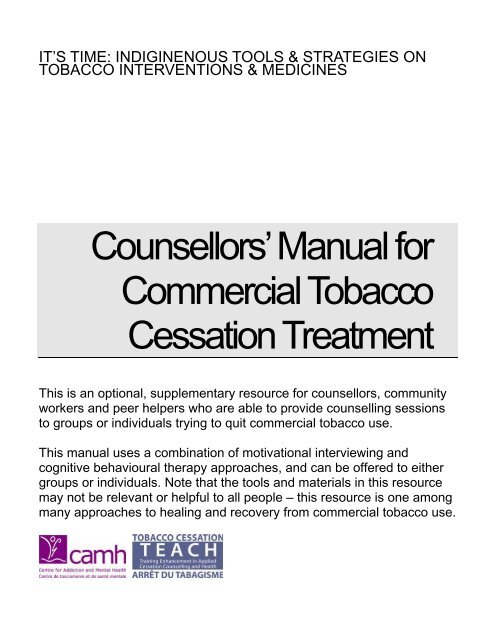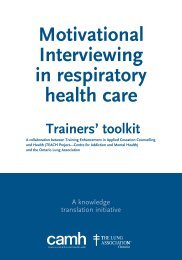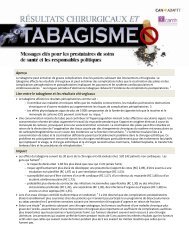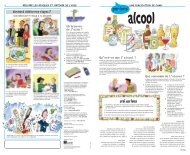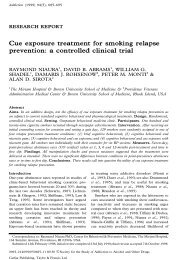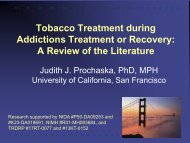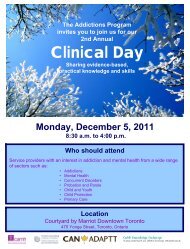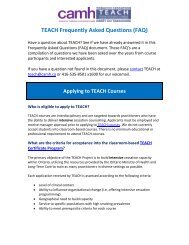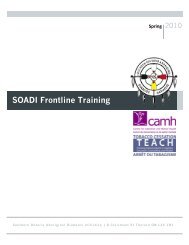Counsellors' Manual for Commercial Tobacco Cessation Treatment
Counsellors' Manual for Commercial Tobacco Cessation Treatment
Counsellors' Manual for Commercial Tobacco Cessation Treatment
You also want an ePaper? Increase the reach of your titles
YUMPU automatically turns print PDFs into web optimized ePapers that Google loves.
IT’S TIME: INDIGINENOUS TOOLS & STRATEGIES ON<br />
TOBACCO INTERVENTIONS & MEDICINES<br />
Counsellors’ <strong>Manual</strong> <strong>for</strong><br />
<strong>Commercial</strong> <strong>Tobacco</strong><br />
<strong>Cessation</strong> <strong>Treatment</strong><br />
This is an optional, supplementary resource <strong>for</strong> counsellors, community<br />
workers and peer helpers who are able to provide counselling sessions<br />
to groups or individuals trying to quit commercial tobacco use.<br />
This manual uses a combination of motivational interviewing and<br />
cognitive behavioural therapy approaches, and can be offered to either<br />
groups or individuals. Note that the tools and materials in this resource<br />
may not be relevant or helpful to all people – this resource is one among<br />
many approaches to healing and recovery from commercial tobacco use.
NICOTINE DEPENDENCE CLINIC, CAMH<br />
© Centre <strong>for</strong> Addiction and Mental Health<br />
2011<br />
This resource may be freely reproduced, adapted and used by any helper or community in accordance with OCAP principles<br />
(Ownership, Control, Access and Possession).
Session<br />
1<br />
Screening and Assessment<br />
This session is designed to give people personalized feedback about their<br />
tobacco use and how it is affecting other areas of their lives. An emphasis is<br />
placed on ensuring that assessment in<strong>for</strong>mation is used clinically to enhance a<br />
person’s motivation and readiness to change.<br />
T<br />
obacco dependence can be a challenging topic to raise with people, particularly when they<br />
are seeking help <strong>for</strong> some other issue. Even opening a conversation about commercial<br />
tobacco use can be a challenge if the person has been accustomed to being “lectured” by<br />
health practitioners, family, friends and the media. Adopting a motivational stance is<br />
important in raising the issue in a non-confrontational, matter-of-fact way. This means:<br />
<br />
<br />
<br />
<br />
<br />
Avoiding arguing<br />
Expressing empathy<br />
Developing discrepancies between a person’s goals and their use of commercial tobacco<br />
Rolling with resistance<br />
Supporting self-efficacy (confidence that they can achieve their goals).<br />
For example, asking the person, “What is the most unusual thing you’ve ever done to make sure<br />
you’d have cigarettes <strong>for</strong> the next morning” can elicit responses that are very helpful in<br />
developing a discrepancy between how a person regards him- or herself, and his or her behaviour.<br />
Examples we have heard in our practice include ordering pizza in order to get cigarettes delivered,<br />
picking cigarettes off the ground, stealing and sifting through cigarette butts in an ashtray. The<br />
important thing is to give people an opportunity to explore and resolve their ambivalence around<br />
changing their use of commercial tobacco. Helpers should strive to avoid attempts to persuade or<br />
confront people about their tobacco use, as this can lead to resistance and disengagement.<br />
The tools in this section can be used in a variety of ways:<br />
<br />
Brief screening tools used in conjunction with other intake or assessment instruments in<br />
your program or service
As a standalone brief assessment of commercial tobacco use<br />
As a more structured follow-up to a short conversation about commercial tobacco use<br />
As the first session in a group or individual treatment program <strong>for</strong> commercial tobacco<br />
cessation.<br />
As a helper, you are the best one to decide – in partnership with your client – how to approach<br />
the topic of commercial tobacco use, what kinds of questions to ask, what kinds of structured<br />
tools to use, and how to build a trusting relationship. In the end, it is the relationship between<br />
helper and client that is the most vital. The tools in this section and throughout this manual are<br />
meant to support an exploration and journey towards healing and recovery, so use or adapt what<br />
is useful and leave the rest.<br />
Note that many of the tools and approaches discussed in this manual have been used with other<br />
kinds of substance use or behaviour change issues – most of them are not specific to commercial<br />
tobacco use (especially the tools in Sessions 2-6). There are some references at the end of this<br />
manual if you would like to access further readings or resources on motivational interviewing,<br />
cognitive behavioural therapy and health behaviour change.<br />
Session 1: Assessment<br />
Clinical Tools<br />
‣ Fagerstom Test <strong>for</strong> Nicotine Dependence<br />
‣ How does commercial tobacco affect you and others in your life (worksheet)<br />
‣ Brief <strong>Commercial</strong> <strong>Tobacco</strong> Use Assessment <strong>for</strong>m<br />
‣ Reasons to Quit Smoking <strong>for</strong>m and Why You Smoke <strong>Commercial</strong> <strong>Tobacco</strong> <strong>for</strong>m<br />
A NOTE ABOUT CALCULATING “PACK YEARS”:<br />
The simple <strong>for</strong>mula <strong>for</strong> calculating pack years is as follows:<br />
# of cigarettes / day X # of years smoked<br />
__________________________________<br />
20<br />
=<br />
___ pack years<br />
For example, a person who smokes 25 cigarettes per day <strong>for</strong> a total of 35 years would have a 43.75 pack year history (25 x 35 =<br />
875; 875 ÷ 20 = 43.75). An online pack year calculator, frequently asked questions and correlations between pack years and<br />
smoking related diseases can be found at: http://smokingpackyears.com/.<br />
One of the utilities of this tool is to help determine which people might be referred <strong>for</strong> spirometry screening which helps detect COPD<br />
(cardio-obstructive pulmonary disease). People with a pack year history of 15 or more, especially those over age 40, should be<br />
referred <strong>for</strong> this type of screening. (Tinkelman et al., 2007).<br />
Tinkelman, D.G., Price, D.B., Nordyke, R.J. and Halbert, R.J. (2007). COPD Screening ef<strong>for</strong>ts in primary care: What is the yield<br />
Primary care Respiratory Journal, 16 (1), 41-48.<br />
3
Fagerstrom Test <strong>for</strong> Nicotine Dependence<br />
Not only is it important to know whether or not your patients smoke, it’s also important to know<br />
how addicted to nicotine they actually are. Fagerstrom’s Test <strong>for</strong> Nicotine Dependence is an easy<br />
way to assess your patient’s addiction. Have your patients answer the questions; each answer gets<br />
a set amount of points. Add up the points and check out the score indicator below:<br />
Questions Answers Points<br />
1. How soon after you wake up do you smoke your<br />
first cigarette<br />
2. Do you find it difficult to refrain from smoking<br />
in places where it is <strong>for</strong>bidden such as church, the<br />
library, or movie theatres<br />
Within 5 minutes<br />
6 to 30 minutes<br />
31-60 minutes<br />
After 60 minutes<br />
Yes<br />
No<br />
3<br />
2<br />
1<br />
0<br />
1<br />
0<br />
3. Which cigarette would you hate most to give up The first one in the morning<br />
All others<br />
1<br />
0<br />
4. How many cigarettes do you smoke (20<br />
cigarettes are<br />
in a pack)<br />
5. Do you smoke more frequently during the first<br />
hours after waking than the rest of the day<br />
6. Do you smoke if you are so ill that you are in<br />
bed most of the day<br />
10 or less<br />
11-20<br />
21-30<br />
31 or more<br />
Yes<br />
No<br />
Yes<br />
No<br />
0<br />
1<br />
2<br />
3<br />
1<br />
0<br />
1<br />
0<br />
Score:<br />
0-2 Very Low Addiction<br />
3-4 Low Addiction<br />
5 Medium Addiction<br />
6-7 High Addiction<br />
8-10 Very High Addiction<br />
Usually, people who score 6 or greater need additional assistance in quitting smoking. This may<br />
mean Nicotine Replacement Therapy or one-on-one counseling to problem solve ways to<br />
overcome barriers and cope with withdrawal symptoms.<br />
This in<strong>for</strong>mation is provided by WHISC - Women’s Health: Interventions <strong>for</strong> Smoking <strong>Cessation</strong>. It is part of the Provider Tool Kit <strong>for</strong> Assisting<br />
Women to Quit Smoking. WHISC is a project funded by a grant from The Duke Endowment to Wake Forest University School of Medicine in<br />
partnership with the Northwest AHEC (North Carolina) Program. January 2001<br />
4
How does commercial tobacco affect you and<br />
others in your life<br />
PHYSICAL<br />
SPIRITUAL<br />
Example: I have a cough<br />
especially in the mornings<br />
Example: <strong>Tobacco</strong> is a gift from the<br />
Creator, and I want to honour that gift<br />
Example: Feeling bad because I want<br />
to set a good example <strong>for</strong> my kids<br />
Example: Thinking about how smoking<br />
cigarettes is hurting my body<br />
EMOTIONAL<br />
MENTAL<br />
5
BRIEF COMMERCIAL TOBACCO ASSESSMENT FORM<br />
I. CURRENT COMMERCIAL TOBACCO USE<br />
Number of<br />
Cigarettes/<br />
day<br />
Importance<br />
Fagerstrom<br />
Test <strong>for</strong><br />
Nicotine<br />
Dependence<br />
Confidence<br />
/10<br />
# of cigarettes / day X # of years smoked<br />
__________________________________<br />
20<br />
=<br />
___ pack years<br />
/10<br />
Readiness to<br />
Change<br />
/10<br />
Goals around <strong>Commercial</strong> <strong>Tobacco</strong> Use<br />
<strong>Cessation</strong> Reduction Undecided<br />
<strong>Commercial</strong> <strong>Tobacco</strong> Use History<br />
Age smoking started ________________ Number of past quit attempts______________<br />
Most recent quit attempt _________________ Longest quit (number of) ___________ months<br />
What led to relapse _____________________________________________________________<br />
Past quit smoking strategies ______________________________________________________<br />
II. COMMENTS<br />
III. SMOKING ENVIRONMENT<br />
Exposure to 2nd hand smoke on a regular basis______________<br />
OTHER COMMENTS ON ENVIROMENT (where you smoke, who you smoke with, etc)<br />
IV. CURRENT MENTAL HEALTH ISSUES AND CURRENT TREATMENT<br />
V. CURRENT MEDICAL CONCERNS AND CURRENT TREATMENT<br />
6
VI. PAST MEDICAL AND/OR MENTAL HEALTH ISSUES AND PREVIOUS<br />
TREATMENT<br />
VII. OTHER SUBSTANCE USE<br />
PRESENT USE<br />
PAST USE<br />
VIII. PSYCHOSOCIAL RELATIONSHIPS<br />
(Include in<strong>for</strong>mation on finances, employment, relationships/ support system, family, legal issues, current<br />
stressors)<br />
IX. TREATMENT PLAN<br />
Include in<strong>for</strong>mation on strengths and resources, traditional healing approaches, other helpers or resources<br />
in the community, and any referrals needed to other programs (if available).<br />
7
Why You Smoke <strong>Commercial</strong> <strong>Tobacco</strong><br />
This scale helps us identify some of the reasons or factor as to why you smoke. If you score higher in some<br />
categories, then these might be the areas that you really need to focus on when you are trying to quit or reduce<br />
your smoking. The higher the number in each category, the more likely that is an area is a factor <strong>for</strong> why you<br />
smoke.<br />
Stimulation _____ wake yourself up, give yourself some energy<br />
Handling _____ like the feel of cigarette in hand, ritual of lighting cig.<br />
Pleasure _____ your reward, smoke in pleasant moods or to celebrate<br />
Coping _____ to cope with negative emotions or stress or trauma<br />
Craving _____ experience physical craving or strong desire to smoke<br />
Habit _____ specific routines, i.e.: after meals, with coffee, in car<br />
Reasons To Quit<br />
This scale will help you identify some of the reasons that are motivating you to quit. It is divided into 3 broad<br />
categories: External (Others want you to quit, financial reasons), Self Image (worried about how cigarettes<br />
make you look and feel about yourself) and Health (worried about current and future health). Again the<br />
higher the score the more likely that is one of the reasons <strong>for</strong> why you would like to quit or reduce your<br />
smoking<br />
External Self Image Health<br />
Opinion of others<br />
Personal Appearance<br />
Images of Illness<br />
_________________<br />
Financial Reasons<br />
_________________<br />
Environmental Factors<br />
_________________<br />
_________________<br />
Responsibility<br />
_________________<br />
Self-Esteem<br />
_________________<br />
_________________<br />
Health deterioration<br />
_________________<br />
Health Improvement<br />
_________________<br />
8
2<br />
Strategize: What are my<br />
reasons <strong>for</strong> change<br />
Session 2 is designed to build on the momentum generated during the<br />
assessment. This session is focused on facilitating an exploring a person’s<br />
ambivalence about changing their use of commercial tobacco.<br />
W<br />
hy change This is a recurring question – and concern – <strong>for</strong> people considering any<br />
change. This session poses the question of why changing commercial tobacco use<br />
might be an important (and desirable) step towards accomplishing other life goals.<br />
For example, the person may want to improve overall health, set a good example <strong>for</strong><br />
their children, or save money. On the other hand, we also recognize that there are powerful<br />
reasons why a person might resist changing: concerns about weight gain, withdrawal symptoms,<br />
coping strategies and losing the enjoyment of smoking are all factors that make it difficult to quit<br />
commercial tobacco use. By using a combination of providing neutral in<strong>for</strong>mation/feedback and<br />
facilitating an exploration of ambivalence, this session helps build motivation.<br />
Providing in<strong>for</strong>mation in a motivational way can be a challenge. The temptation is to adopt a<br />
warning or lecturing posture in communicating health effects or reasons <strong>for</strong> change. The danger<br />
in this stance lies in the fact that it does not leave the person space to articulate his or her most<br />
compelling reasons <strong>for</strong> change. Here are some tips <strong>for</strong> providing in<strong>for</strong>mation more<br />
“motivationally”:<br />
1. Ask permission: Preface your comments with a statement such as, “I’d like to take the<br />
next few minutes to go over some of the myths and facts about smoking. How does that<br />
sound to you” This invites “conversational consent” from the person or group, and sets<br />
the stage <strong>for</strong> a more productive discussion. An alternative “permission question” could be<br />
something along the lines of, “Would it be helpful to briefly go over some of the longer<br />
term risks associated with smoking as few as 10 cigarettes per day” It is often the case<br />
that a person comes to counselling with a wealth of in<strong>for</strong>mation already. Asking<br />
permission respects the possibility that a person may already know what we are going to<br />
tell them!<br />
2. Provide the in<strong>for</strong>mation in a neutral, non-dramatic way: It is hard to overstate the<br />
risks of smoking cigarettes. However, by maintaining neutrality when we provide<br />
in<strong>for</strong>mation we acknowledge that people may choose to disregard our teachings…and in<br />
the end, a decision to change can only be made by the individual. It is always better <strong>for</strong><br />
the client to express surprise, concern or dismay than <strong>for</strong> the helper to do so.
3. Beware of overloading a person with too much in<strong>for</strong>mation: The handouts included<br />
in this section are designed to be read by the person, and discussed in the group or the<br />
individual counselling session. It is helpful to touch on key points or questions, and use<br />
these as “jumping off” points <strong>for</strong> discussion and reflection.<br />
4. When finished providing in<strong>for</strong>mation, ask “How does that fit <strong>for</strong> you” or “What<br />
do you make of that” These questions give a person the opportunity to reflect on how<br />
(or whether) the in<strong>for</strong>mation provided relates to his or her own life, experiences and<br />
goals.<br />
It can be also be useful to have a person reflect on their feelings and expectations about<br />
counselling. For example, many people who have never attended group counselling may be<br />
anxious about the amount or type of disclosures that are expected. An important task in building<br />
cohesion in group treatment contexts is to teach people how to be “good group members”,<br />
through modeling and feedback. Here are some sample questions to start a discussion of group<br />
process issues, as well as build group cohesion:<br />
<br />
<br />
<br />
<br />
<br />
“What was it like <strong>for</strong> you to sit in this circle”<br />
“What are some of the things you are wondering about this group”<br />
“What needs to happen here in order <strong>for</strong> you to feel like this is a really helpful<br />
experience <strong>for</strong> you”<br />
“What would be important <strong>for</strong> us to do to support each other”<br />
“What are some ground rules or guidelines we should adopt in this group in<br />
order <strong>for</strong> everyone to feel respected and safe”<br />
The above questions can also be modified <strong>for</strong> use in individual sessions, in order to build rapport<br />
and trust. Setting a supportive tone and fostering a psychologically safe climate are crucial in<br />
counselling. Encouraging group members to interact with one-another (as opposed to directing all<br />
communication through the helper), periodically pausing to reflect on group process (as opposed<br />
to a strict content focus), and being explicit about group norms, goals and patterns of interaction<br />
can all help foster cohesion and mutual support.<br />
A client and a helper can work together to develop a strategy that mobilizes existing support<br />
systems, coping strategies, and medicines (both traditional and non-traditional). Even be<strong>for</strong>e<br />
setting s quit date, a person should be encouraged to begin to implement such strategies as:<br />
• Keep track of when and how many cigarettes smoked, including thoughts and feelings –<br />
this helps identify risky situations and possible triggers.<br />
• Thinking about and talking about the costs and benefits of quitting versus continuing to<br />
smoke commercial tobacco.<br />
• Completing a Decisional Balance exercise and reflecting on the costs and benefits of<br />
quitting versus continuing to smoke.<br />
10
Session 2: Dealing with ambivalence<br />
Clinical Tools<br />
o Reasons <strong>for</strong> Change <strong>for</strong>m<br />
o Decisional Balance <strong>for</strong>m<br />
o Readiness Ruler<br />
o<br />
Traditional Alternative to Readiness Ruler: TOBACCO CESSATION MEDICINE WHEEL - AN ANISHNAWBEK<br />
APPROACH<br />
o Daily Diary – NOTE: You might find it helpful to make several copies of the Daily Diary, and encourage a<br />
person to complete this every week, <strong>for</strong> discussion during each counselling session.
Reasons <strong>for</strong> Change<br />
Making a commitment to meeting your goal is important to your success. Sometimes, it’s<br />
easy to <strong>for</strong>get why you’re making the change, so write down your reasons and use this as a<br />
reminder to yourself when things seem tough!<br />
The most important reasons that I want to change are:<br />
1. _______________________________________________________________<br />
_______________________________________________________________<br />
_______________________________________________________________<br />
2. _______________________________________________________________<br />
_______________________________________________________________<br />
_______________________________________________________________<br />
3. _______________________________________________________________<br />
_______________________________________________________________<br />
_______________________________________________________________<br />
12
Decisional Balance Sheet<br />
Try to fill out personal reasons <strong>for</strong> why you continue to smoke commercial tobacco or why you may want to quit.<br />
Benefits of:<br />
Continue Smoking<br />
o Reward<br />
o Helps getting started in the morning<br />
(routine)<br />
o Helps me deal with stress<br />
Quit Smoking<br />
o Feel better about myself<br />
o Set a good example <strong>for</strong> children and<br />
community<br />
o Save money<br />
Costs of:<br />
o Smells bad<br />
o Costs too much<br />
o Skin damage<br />
o Out of breath when I walk<br />
o It will be hard to quit<br />
o I will miss smoking<br />
o Other people might not support me<br />
wanting to quit<br />
13
Readiness Ruler<br />
Now that you have thought about some of your reasons <strong>for</strong> change, where would<br />
you rate the importance of actually making these changes How confident do<br />
you feel about whether you can make this change How ready are you to start<br />
the journey of change<br />
How important is it to change this behaviour<br />
How confident are you that you could make this change<br />
How ready are you to make this change<br />
14
TOBACCO CESSATION MEDICINE WHEEL<br />
AN ANISHNAWBEK APPROACH<br />
YOUR HEALTH & WELL-BEING - IT’S UP TO YOU!<br />
10<br />
MENTAL ASPECT<br />
OF QUITTING TOBACCO<br />
eg: poor judgment/decision making, difficulty<br />
concentrating, bipolar illnesses, depression, etc.<br />
How confident are you that you could make this change<br />
PHYSICAL ASPECT OF TOBACCO USE<br />
SPIRITUAL ASPECT OF QUITTING<br />
TOBACCO<br />
10 How has your tobacco use impacted you<br />
How has quitting in the past affected you<br />
0<br />
eg: confusion, loss of<br />
connectedness, and/or<br />
problems in the physical,<br />
emotional or mental aspects.<br />
10<br />
How ready are you to make this<br />
change<br />
EMOTIONAL ASPECT<br />
OF QUITTING TOBACCO<br />
eg: low self-esteem, loss of ability to<br />
cope, relationship difficulties, etc.<br />
How important is it to change this behaviour<br />
10<br />
Anishnawbek teachings maintain that a person contains the four directions which must be in balance to achieve health. This wheel is<br />
combination of these teachings and the work of the TEACH project and motivational interviewing.<br />
The numbers serve as a guide to help the person(s’) explore change and gives the helper an idea of the balance of the person(s)<br />
The Gifts of the Seven Grandfathers (which are interwoven into daily life) are given to the people to help them understand and attain health and<br />
well-being.<br />
15
Daily Diary<br />
Date<br />
Behaviour<br />
(How many<br />
cigarettes<br />
today)<br />
Describe the situation (eg. Were<br />
you alone or with others, at home in<br />
a social setting)<br />
Thoughts and Feelings (What<br />
were you thinking and feeling in<br />
this situation)<br />
Monday<br />
Tuesday<br />
Wednesday<br />
Thursday<br />
Friday<br />
Saturday<br />
Sunday<br />
16
3<br />
Strategize: Setting a Quit Date<br />
Session 3 is focused on working with people around making a decision to<br />
change. Although not everyone may be ready to set a quit date or make a clear<br />
decision, the session content can be adapted to continuing the work around<br />
addressing ambivalence (Session 2).<br />
M<br />
aking a decision to change can be an intimidating process, particularly when it involves<br />
giving up a long-term behaviour, such as smoking commercial tobacco. There<strong>for</strong>e, the<br />
emphasis on this session is to continue to build motivation by focusing on the tools<br />
and strategies that can be helpful in changing commercial tobacco use. For some<br />
people, the decision to change may involve cutting down (as opposed to quitting). For many<br />
people, this is the most realistic first step, and harm reduction is a step in the right direction. In all<br />
cases, the feasibility and reasonableness of a person’s goal should be addressed.<br />
For a person who is not yet ready to change their use of commercial tobacco, the focus on this<br />
session can remain on barriers to change, as well as possible strategies <strong>for</strong> overcoming those<br />
barriers. A goal statement <strong>for</strong> someone not ready to quit might focus on a goal to smoke outside<br />
to prevent other people and animals in the home from the effects of second-hand smoke. If<br />
smoking is a way to cope with stress, the person’s goal might be to first try one or two other<br />
useful strategies <strong>for</strong> stress management be<strong>for</strong>e having a cigarette, and noting how helpful these<br />
alternative strategies are.<br />
Nicotine replacement medications (such as the nicotine patch, gum, lozenge or inhaler) can also<br />
be discussed in this session, and can be introduced as an option <strong>for</strong> anyone who is interested,<br />
regardless of their willingness or perceived ability to set a change goal at this time.<br />
A person completes the Goal Statement and another Readiness Ruler in this session. Note that an<br />
interim goal (such as smoking outside or cutting down on the number of cigarettes smoked) may<br />
be set if the person is not ready or willing to set a quit date at this time.<br />
It is also helpful to explore traditional healing approaches: <strong>for</strong> example, healing circles, prayer,<br />
offerings to the creator, teachings from an Elder, fasts or sweats can be powerful ways to support<br />
and heal a person in his or her recovery.
Session 3: Making a Decision to Change<br />
Clinical Tools<br />
o Preparing <strong>for</strong> Quit Day handout<br />
o How Fast Will I Improve Handout<br />
o What withdrawal symptoms can I expect Handout<br />
o Quitting Cold Turkey versus Cutting Down (handout)<br />
o Myths and Facts of Nicotine Replacement Therapies Quiz<br />
o Goal Statement & Readiness Ruler<br />
Note that there are many handouts and tools in this<br />
section – talk to your client about which one(s) would be<br />
the most helpful.<br />
18
Preparing <strong>for</strong> Quit Day<br />
<br />
<br />
<br />
<br />
<br />
<br />
<br />
<br />
<br />
<br />
<br />
<br />
<br />
A few weeks prior to quit day, limit your smoking to only one room in your home or<br />
completely make it smoke free. This room should be the least com<strong>for</strong>table room in<br />
your house.<br />
Clean out your car and clean / deodorize your home.<br />
Visit your dentist to get your teeth cleaned. With the tar and nicotine removed from<br />
your teeth you are literally starting with a fresh mouth.<br />
Monitor alcohol and caffeine consumption be<strong>for</strong>e and after quit date as these can been<br />
seen as triggers to use. Cut down on caffeine after you quit, because people who don’t<br />
smoke commercial tobacco are more sensitive to caffeine (<strong>for</strong> example, coffee will<br />
have a stronger effect after you quit smoking).<br />
Get lots of rest leading up to your quit day.<br />
Drink lots of fluids as this can help with cravings.<br />
Use healthy substitutes such as sugarless gum, carrot sticks, sunflower seeds, raisons<br />
etc. This will help keep your mouth stimulated.<br />
Repeat your reasons <strong>for</strong> quitting or post a list on your fridge where you will be<br />
constantly be reminded.<br />
Plan activities <strong>for</strong> your first week of being smoke free. Keeping yourself occupied is<br />
important as well as planning activities that do not place you in situations where you<br />
will be tempted to smoke.<br />
Occupy your hands with toothpicks, pencil, rubber bands, stress balls, etc…<br />
Be aware of cigarette advertisements or other triggers.<br />
Never allow yourself to think that one cigarette won’t hurt. Many smokers relapse<br />
when they believe they can control their smoking. This is harmful because even if you<br />
are able to control your cigarette consumption <strong>for</strong> awhile it generally ends up<br />
increasing to where it was be<strong>for</strong>e you quit.<br />
Use your support system and don’t be afraid to ask <strong>for</strong> help from community members,<br />
Elders, family etc.<br />
19
How fast will I improve after I stop using commercial tobacco<br />
Everyone improves after quitting smoking at varying rates. This may be dependent on amount smoked,<br />
years smoked, if you are exposed to second hand smoke (among other factors).<br />
Immediately<br />
The air around you and your family and friends is safer.<br />
Within 20 minutes of<br />
last cigarette<br />
After 8 hours<br />
Blood pressure drops<br />
Pulse rate drops to normal<br />
Body temperature of hands and feet increases to normal<br />
Carbon Monoxide level in blood drops<br />
After 24 hours<br />
Chance of heart attack decreases<br />
After 48 hours<br />
Nerve endings may re-grow<br />
Ability of smell and taste enhanced<br />
After 72 hours<br />
Bronchial tubes relax; if undamaged, will make breathing easier<br />
Lung capacity increases<br />
2 weeks to 3 months Circulation improves<br />
Walking becomes easier<br />
Lung functioning may increase up to 20%<br />
1 – 9 months Coughing, sinus congestion, fatigue, shortness of breath may decrease<br />
Potential <strong>for</strong> cilia in lungs to re-grow, increasing ability to handle mucus, clean<br />
the lungs and reduce infection<br />
1 year The risk of heart disease is reduced by half of someone who continues to smoke<br />
20
2 years Cervical cancer risk reduced compared to people who continue to smoke<br />
Bladder cancer risk halved compared to continuing smokers<br />
5 – 15 years Stroke risk is reduced to that of a nonsmoker!<br />
10 years Risk of cancer of the lung, mouth, throat, esophagus, kidneys and pancreas<br />
decreases<br />
Document prepared by CAMH Nicotine Dependence Clinic – adapted from:<br />
http://www.quittobacco.org/whyquit/physicalbenefits.html<br />
21
What Withdrawal Symptoms Can I Expect<br />
Each individual can experience very different withdrawal symptoms from quitting commercial tobacco. Most<br />
people will experience the worst physical withdrawal symptoms within the first 3 – 5 days. If a symptom<br />
persists or seems worse you should see a doctor or nurse practitioner. Here are some things you may<br />
experience when quitting commercial tobacco use (cigarettes or smokeless tobacco).<br />
‣ Occasional dizziness – This is caused by the fact that you are now absorbing more oxygen through<br />
your lungs. The dizziness may come upon you <strong>for</strong> a few days and usually lasts <strong>for</strong> only a few<br />
seconds.<br />
‣ Headache – One in four smokers reports a mild headache at some point during their quitting<br />
process.<br />
‣ Hunger – Almost all smokers notice this symptom. Nicotine is an appetite suppressant so you feel<br />
like eating more. The body’s absorption of food is improved too, so that you gain more nourishment<br />
even if you do not actually increase the amount you eat. It is important to note that not all people<br />
gain weight when they quit and healthy eating and exercise can help to curb this.<br />
‣ Constipation – Intestinal motility may decrease <strong>for</strong> a brief period when you quit cigarettes. This<br />
usually lasts <strong>for</strong> only 3 – 4 days. If you have further concerns about this please see a health<br />
practitioner.<br />
‣ Shakiness – You may notice your hands tremble slightly, perhaps <strong>for</strong> several weeks. The tremor<br />
usually subsides as your body gets used to its new non-smoking environment.<br />
‣ Sweating – This is another common reaction. Like the shakes, it will go away after a while. Hot baths<br />
or showers can dispel the perspiration.<br />
‣ Coughing more – As the cilia in your lungs rebuild, they start to clean the bronchial tubes and<br />
remove the phlegm, thus causing increase in coughing. This can last <strong>for</strong> a few weeks and results in<br />
the disappearance of the “smoker’s cough”.<br />
‣ Other symptoms you may experience include: decreased concentration, feeling fatigued,<br />
nervousness, irritability, anxious, or sadness. These are normal, and they are part of physical,<br />
emotional and spiritual healing from commercial tobacco.<br />
22
Cold-Turkey vs. Cutting Down<br />
We are often asked which strategy is the best way <strong>for</strong> quitting commercial tobacco use. Un<strong>for</strong>tunately there<br />
is no easy answer and this decision depends on each individual’s preferences, strengths and weaknesses.<br />
Consider the following in<strong>for</strong>mation be<strong>for</strong>e making your decision.<br />
Cold-Turkey<br />
When a person quits cold turkey this means that he/she has gone from smoking his/her normal amount of<br />
cigarettes to abruptly stopping completely. The amount of nicotine in blood stream quickly drops off. As a<br />
result, the body may experience some withdrawal symptoms (restless, irritable, appetite changes, sleep<br />
disturbances, headache, fatigue, coughing etc.). The benefit of quitting this way is that it is quick and your<br />
body begins to heal itself immediately.<br />
Cutting down or tapering<br />
Some people decide to cut down the number of cigarettes that they smoke and thereby reduce the amount<br />
of nicotine in the body. The benefit to this process is the potential reduction of withdrawal symptoms.<br />
However some people find that it is difficult <strong>for</strong> them to maintain a lower level of nicotine because the body<br />
begins to crave the original amount that the smoker was consuming. There<strong>for</strong>e they may find themselves<br />
going up and down with the amount that they smoke because the body may experience mini withdrawal<br />
symptoms. To prevent this from happening nicotine replacement therapies were developed. These<br />
products were designed to lower the amount of nicotine in the body gradually to minimize withdrawal.<br />
Whatever method of quitting you decide upon, it is important to be prepared. If you decide to go coldturkey,<br />
know what you are going to do on your quit date and have supports in place to help you through<br />
your chosen date. Alternatively, if you are going to taper down, there are many strategies that you can use to<br />
help you through this process.<br />
23
Myths and Facts about stop-smoking medications<br />
How much do you know about medications to help people quit smoking Take<br />
this True-or-False quiz and find out (answers are at the bottom).<br />
Myth or Fact<br />
1. Nicotine is one of the harmful substances in cigarettes.<br />
2. Nicotine addiction is equally likely whether the nicotine is obtained<br />
from cigarettes, nicotine patch, gum, lozenge or inhaler.<br />
3. Nicotine patches, gum, lozenge and inhalers carry significant health<br />
risks if used by people who smoke.<br />
4. Smoking while on the patch causes heart attacks.<br />
5. People with heart disease should not use nicotine replacement<br />
medications.<br />
6. Pregnant women should never use nicotine replacement<br />
medications.<br />
7. People under age 18 should never use nicotine replacement<br />
medications.<br />
8. Stop-smoking medications should not be used in combination with<br />
one-another.<br />
9. People using nicotine replacement medications should not exceed<br />
the dose recommended on the medication package.<br />
10. Stop-smoking medications are only appropriate <strong>for</strong> short-term use.<br />
11. Nicotine replacement medications should not be used by people<br />
who just want to cut down on the number of cigarettes they smoke.<br />
True or False<br />
Answers:<br />
1. False: The thousands of toxins in tobacco smoke are harmful. Nicotine is not associated with cancers or chronic respiratory conditions.<br />
2. False: Cigarettes are far more addictive than nicotine replacement, primarily because of how they deliver nicotine.<br />
3. False: Nicotine replacement therapy is safe <strong>for</strong> smokers.<br />
4. False: The use of nicotine replacement does not increase cardiovascular risk,<br />
5. False: It is more dangerous <strong>for</strong> people with heart disease to continue smoking than to use nicotine replacement, and many such patients are not able to<br />
quit on their own.<br />
6. False: nicotine replacement is safer <strong>for</strong> the fetus than smoking, and is appropriate <strong>for</strong> pregnant women who are unable to quit using behavioural<br />
interventions.<br />
7. False: Most daily smokers begin smoking be<strong>for</strong>e age 18, and are already getting nicotine from cigarettes. Nicotine replacement should be considered <strong>for</strong><br />
youth who are regular smokers who are unable or unwilling to quit using behavioural interventions.<br />
8. False: The nicotine patch/gum/lozenge/inhaler can be used at the same time and/or in combination with bupropion (Zyban).<br />
9. False: Smokers should be in control of how and how much they use nicotine replacement medications.<br />
10. False: Nicotine replacement should be used <strong>for</strong> as long as needed to maintain or prolong tobacco abstinence.<br />
11. False: Nicotine replacement can be used by people who are not ready to quit as a way to reduce their smoking, and progress towards a longer-term<br />
goal of abstinence.<br />
(adapted from Ontario Medical Association Position Paper: Rethinking stop-smoking medications: <strong>Treatment</strong> myths and medical<br />
realities, January, 2008).<br />
24
Goal Statement<br />
The behaviour I want to/need to change is:<br />
_____________________________________________________<br />
_____________________________________________________<br />
_____________________________________________________<br />
What is your goal now<br />
_____________________________________________________<br />
_____________________________________________________<br />
_____________________________________________________<br />
Start date: ______________________________<br />
Achievement date: _______________________<br />
Tip – If you are not ready to quit commercial tobacco, think about what a small goal<br />
might be. One example might be to not smoke in your car, to smoke outside, or to not<br />
smoke <strong>for</strong> a three hour period each day <strong>for</strong> a week. Any others<br />
25
Readiness Ruler<br />
Now that you have set a goal, where would you rate the importance of you goal<br />
How confident do you feel now in accomplishing your goal How ready are you<br />
to continue the journey of change After you have completed this sheet, go back<br />
and compare your responses with the one you completed in the last session.<br />
How important is it to change this behaviour<br />
How confident are you that you could make this change<br />
How ready are you to make this change<br />
26
4<br />
Take Action<br />
Session 4 builds on the person’s goal statements by asking him or<br />
her to identify what might stand in the way of accomplishing these<br />
goals. In Session 4 we are asking people to examine their major<br />
risk situations <strong>for</strong> commercial tobacco use. The work in this session<br />
sets the stage <strong>for</strong> the development of concrete plans <strong>for</strong> preventing<br />
relapse, covered in Session 5.<br />
I<br />
dentifying high-risk situations is an important step towards being able to develop<br />
a way to deal with triggers to use commercial tobacco. This session is focused on<br />
a detailed look at the person’s major areas of risk. It can be a challenge <strong>for</strong> a<br />
person who uses commercial tobacco in so many different settings and<br />
circumstances to come up with three major triggers…especially in the early days and<br />
weeks of quitting or cutting down tobacco use. However, the process of figuring out<br />
the states of mind, settings, times of day or other triggering events is key to coming up<br />
with an effective coping plan. Even opening the conversation gives a person some<br />
“food <strong>for</strong> thought” around beginning to anticipate – and plan <strong>for</strong> – the situations that<br />
will be especially difficult.<br />
Here are some suggestions of common risk situations to get the conversation started:<br />
First thing in the morning, or just be<strong>for</strong>e going to bed<br />
After meals<br />
While driving<br />
With a coffee<br />
While on the phone<br />
In a social setting<br />
With particular people (friends or family members)
When feeling upset, sad or angry.<br />
The discussion of triggers is complemented in this session by also focusing on possible<br />
coping strategies. Important messages to rein<strong>for</strong>ce are that change is possible, and even<br />
the most severe cravings will pass.<br />
For example:<br />
Changes in mood = what further support is needed<br />
Withdrawal symptoms = re-assess medicines or think about using nicotine<br />
replacement<br />
Low motivation = review Decisional Balance and Reasons <strong>for</strong> Change exercises<br />
Weight gain = recommend physical activity, healthy eating, additional support<br />
Lapses or slips = explore triggers and coping strategies; continue self-monitoring<br />
Perhaps most important of all, especially if the person has been experiencing some<br />
difficulties in meeting his or her goal, is to congratulate him or her <strong>for</strong> coming back to<br />
see you, and <strong>for</strong> the ef<strong>for</strong>t of trying. Remind the person that quitting smoking is not an<br />
event, it is a process!<br />
In this session, it is suggested that you complete with the person the Triggers and<br />
Consequences work sheet and/or the Change Plan Work Sheet.<br />
28
Session 4: Making a Decision to Change<br />
Clinical Tools<br />
o Triggers and Consequences Worksheets<br />
o Change Plan Worksheet<br />
o General Coping Strategies (handout)<br />
o Healing from <strong>Commercial</strong> <strong>Tobacco</strong> Use – Some Traditional Approaches (handout)<br />
Note that there are many handouts and tools in this section<br />
– talk to your client about which one(s) would be the most<br />
helpful.
Triggers and Coping Skills<br />
Sample Plan<br />
Triggers<br />
Coping Skills<br />
Smoke with friend every<br />
day at breaks<br />
Tell friend “I am quitting”<br />
After meals<br />
Chew gum after meals; get up<br />
from table right away<br />
Stress at work gets too<br />
much on some days<br />
Plan to take walks when<br />
stress is high<br />
Triggers<br />
Coping Skills<br />
30
Change Plan Worksheet<br />
The changes I want to make are:<br />
________________________________________________________________________<br />
________________________________________________________________________<br />
The most important reasons why I want to make these changes are:<br />
________________________________________________________________________<br />
________________________________________________________________________<br />
The steps I plan to take in changing are:<br />
________________________________________________________________________<br />
________________________________________________________________________<br />
The ways other people can help me are:<br />
________________________________________________________________________<br />
________________________________________________________________________<br />
I will know that my plan is working if:<br />
________________________________________________________________________<br />
________________________________________________________________________<br />
Some things that could interfere with my plan are:<br />
________________________________________________________________________<br />
________________________________________________________________________<br />
31
General Coping Strategies<br />
Things I can do Thoughts that can help Coping with feelings<br />
Visit an Elder or Knowledge<br />
Keeper and offer to be a helper<br />
Attend a sweat lodge ceremony<br />
Smudge<br />
Have a cedar bath<br />
Drink a cup of cedar tea<br />
Go in the bush<br />
Sit by the water<br />
Make a tobacco offering in<br />
gratitude <strong>for</strong> the day<br />
Avoid people or places that<br />
trigger problematic coping<br />
strategies (i.e. tobacco use,<br />
drinking, drug use, self-harm)<br />
Identify and avoid high-risk<br />
situations.<br />
Take a “buddy” when going to a<br />
risky place /situation.<br />
Leave risky situations, or limit<br />
how long you stay.<br />
Phone someone <strong>for</strong> support<br />
Go <strong>for</strong> a walk.<br />
Read a book.<br />
Exercise or do something<br />
physical.<br />
Stand tall and feel your body’s<br />
strength. Remind yourself that<br />
you are a strong person.<br />
Hold onto something to ground<br />
yourself (chair you are sitting in,<br />
key ring, picture etc.)<br />
Clean or do housework.<br />
Offer a daily prayer of gratitude<br />
Talk to an Elder or Knowledge<br />
Keeper about the Seven<br />
Grandfather teachings<br />
Think kind thoughts about yourself<br />
Remember the positive things<br />
about using healthy coping<br />
strategies.<br />
Remember the negative<br />
consequences of using<br />
problematic coping strategies.<br />
Tell yourself that feelings, even<br />
difficult feelings, are normal.<br />
Distract yourself by thinking about<br />
something else.<br />
Recognize when you are making<br />
self-defeating statements or<br />
rationalizations (i.e., I am such a<br />
loser).<br />
Plan ahead <strong>for</strong> any risky situations<br />
or “loopholes” to your plan.<br />
Imagine a stop sign when you are<br />
having intrusive thoughts or<br />
imagery.<br />
Think about your future goals and<br />
how to achieve them.<br />
Remind yourself that you only<br />
have to worry about what you have<br />
control over today.<br />
Remind yourself that you are in the<br />
present and the past cannot hurt<br />
you now.<br />
Make a commitment to yourself<br />
and remind yourself of it.<br />
Think that you are in charge of<br />
whatever decisions you make<br />
about your safety.<br />
☯ Talk to an Elder or<br />
Traditional Healer<br />
☯ Acknowledge your<br />
internalized oppression<br />
☯ Read inspiring literature on<br />
self-growth or recovery.<br />
☯ Ask yourself what you are<br />
feeling (go through a<br />
checklist of your common<br />
“feeling triggers” –am I<br />
lonely, sad, anxious,<br />
scared).<br />
☯ Give yourself permission to<br />
feel emotions (don’t judge<br />
your feelings).<br />
☯ Express your feelings (cry,<br />
smile, etc.,).<br />
☯ Ask <strong>for</strong> support.<br />
☯ Talk to someone about your<br />
feelings.<br />
☯ Find a creative outlet <strong>for</strong><br />
feelings (music, drawing,<br />
painting, poetry etc.,).<br />
☯ Get a journal and write to<br />
yourself.<br />
☯ Take time to soothe /<br />
nurture yourself.<br />
☯ Praise yourself <strong>for</strong> the<br />
progress you have made.<br />
☯ Use affirmations.<br />
☯ Light candles to help you to<br />
focus on your thoughts and<br />
feelings.<br />
☯ Write a letter to someone<br />
about how you are feeling (it<br />
32
Do volunteer work<br />
Try meditation, deep breathing,<br />
and relaxation tapes.<br />
Try new hobbies or leisure<br />
activities.<br />
Practice saying no with both<br />
your voice and body language.<br />
Stay in contact with supportive<br />
people.<br />
Take care of yourself if you are<br />
hungry, thirsty or tired.<br />
Keep a visual reminder of the<br />
negative consequences of your<br />
problematic coping strategies<br />
(i.e. court papers, photos)<br />
Keep visual reminders or<br />
written lists of the positive<br />
consequences of the changes<br />
you’ve made.<br />
Reward yourself <strong>for</strong> your<br />
ef<strong>for</strong>ts.<br />
Go to a support group.<br />
Listen to music. Sing. Dance.<br />
Cook and eat nutritious food.<br />
Practice being kind to yourself<br />
Tell yourself that you are doing<br />
well so far and don’t want to<br />
interfere with the progress.<br />
When feeling overwhelmed, make<br />
a pro / con list and limit your<br />
decisions until you feel less<br />
overwhelmed.<br />
Monitor your use and urges to use<br />
problematic coping strategies<br />
Think about the times in your life<br />
(even if few) where you have felt<br />
good about yourself. Try to get in<br />
touch with the feelings of strength<br />
and success that went along with<br />
those events.<br />
<br />
When a negative belief about<br />
yourself pops into your head, try to<br />
remember where it really came<br />
from—who originally planted those<br />
beliefs Think about challenging<br />
them with other in<strong>for</strong>mation that<br />
you know about yourself, which<br />
proves the beliefs to be false.<br />
Be aware of any tendency you<br />
have to make general statements<br />
about yourself. Being human<br />
means having good and bad days.<br />
Post a copy of the Seven<br />
Grandfather teachings where you<br />
can review it each day<br />
is better to not send the<br />
letter, keep it, burn it, bury it,<br />
flush it).<br />
☯ Get a punching bag, or hit a<br />
pillow or bed, scream into a<br />
pillow.<br />
☯ Throw rocks in the lake<br />
☯ Talk to a pet / spend time<br />
with animals.<br />
☯ Go to a spiritual place<br />
(anyplace you define as<br />
spiritual).<br />
☯ Create a safe or sacred<br />
place in your home.<br />
☯ Be kind to yourself.<br />
☯ If you are afraid of being<br />
overwhelmed by your<br />
emotions, imagine them<br />
coming through a tap where<br />
you are able to control the<br />
flow<br />
33
Healing from commercial tobacco use: some traditional approaches<br />
The following are ideas and suggestions and may not necessarily apply to all Nations. We recognize there are no<br />
universal or pan‐Aboriginal approaches to healing commercial tobacco use.<br />
A community member should always begin their traditional healing path by consulting with people s/he trusts to get<br />
referrals to respected and recognized Traditional Healers, Elders and Medicine People within his/her community or<br />
organization. An Elder in the community would be willing to help the community member who wants to quit by being<br />
available throughout the process of their journey toward becoming a non‐smoker. When you seek the help and advice<br />
of an Elder, Healer or Medicine Person, and give your offering of tobacco, they know that a request may be made as<br />
tobacco is so sacred.<br />
<strong>Tobacco</strong> is the first plant that the Creator gave to the peoples of Turtle Island. It is used as an offering <strong>for</strong> everything in<br />
every ceremony. “Always through tobacco,” the saying goes. Traditional tobacco was given to us so that we can<br />
communicate with the spirit world. It opens up the door to allow that communication to take place. When we make an<br />
offering of tobacco, we communicate our thoughts and feelings through the tobacco as we pray <strong>for</strong> ourselves, our<br />
family, relatives and others.<br />
<strong>Tobacco</strong> has a special relationship to other plants: it is said to be the main activator of all the plant spirits. It is like the<br />
key to the ignition of a car. When you use it, all things begin to happen. <strong>Tobacco</strong> is always offered be<strong>for</strong>e picking<br />
medicines. When you offer tobacco to a plant and explain why you are there, that plant will let all the plants in the area<br />
know why you are coming to pick them.<br />
We express our gratitude <strong>for</strong> the help the spirits give us through our offering of tobacco. It is put down as an offering of<br />
thanks to the First Family, the natural world after a fast. Traditional people make an offering of tobacco each day when<br />
the sun comes up.<br />
Traditional tobacco is still grown in some communities. For example, the Haudenosaunee people use a traditional<br />
tobacco that they grow themselves and that is very sacred to them. <strong>Tobacco</strong> along with sage, cedar and sweetgrass<br />
make up the Four Sacred Medicines.<br />
In addition to speaking to a traditional person and making offerings, a community member can also find healing through<br />
ceremony such as:<br />
- daily smudges with the sacred medicines and prayers<br />
- going on a fast<br />
- going to a sweat<br />
Many options are available <strong>for</strong> reconnecting with traditional activities, replacing unhealthy environments and activities<br />
with healing ones, or distracting ones hands from the habit of cigarette smoking, such as:<br />
- spending time in the bush<br />
- traditional, jingle, fancy shawl, grass, chicken, etc. dancing<br />
- beadwork and craft‐making<br />
- hunting, trapping, cooking traditional foods<br />
- singing<br />
- drumming<br />
(In part adapted from “The Four Sacred Medicines”. Anishnawbe Health Toronto, 2000, and through consultation with<br />
the Enaahtig Healing Lodge and Learning Centre.)<br />
34
5<br />
Optimize Your Plan<br />
In Session 4, the person was asked to identify some major triggers <strong>for</strong> commercial<br />
tobacco use, and to think about ways to cope. In this session, the person will examine<br />
what is working well and what needs further change to “optimize” the plan of action.<br />
This session and the last session (Session 6) are devoted to “fine-tuning” and testing<br />
out various coping strategies and supports.<br />
A<br />
sking <strong>for</strong> feedback from others is the primary focus of the fifth treatment session. Who are the<br />
most helpful supports to changing commercial tobacco use These can include Elders, family<br />
members, friends, colleagues or health professionals. The person is encouraged to ask <strong>for</strong><br />
feedback on his or her plan of action, identify what is missing or what he or she could try to do<br />
differently, and to watch <strong>for</strong> saboteurs (people who are not supportive of change).<br />
During this session, the helper could coach the person on ways to ask <strong>for</strong> specific feedback. This might<br />
include identifying a number of possible options <strong>for</strong> each trigger or risk situation, and asking <strong>for</strong> specific<br />
feedback on what might work best. The concept of “options” can be difficult to communicate to people.<br />
Here is a suggested way of framing this task:<br />
“In the past, commercial tobacco has been a way to cope with the trigger situations we talked about<br />
last week. But, if you think about it, people who don’t smoke also experience similar triggers… they<br />
just cope (or behave) in different ways. This week, we’re going to look at some of the other things<br />
you could do when you’re confronted with one of these triggers. The more options you come up<br />
with the better.”<br />
Providing some concrete examples can be helpful in clarifying the task. Some possibilities include:<br />
Trigger:<br />
Options:<br />
o Smoking while drinking coffee in the morning<br />
o Switching to tea or juice<br />
o Drinking coffee in a place that doesn’t allow smoking (like a coffee shop)
o Changing my morning routine<br />
o Quitting coffee completely<br />
o Continuing to have my morning coffee at home, but not smoking<br />
After the person has generated three or more options, they are asked to reflect on the likely consequences<br />
of each option – both short- and long-term, and positive and negative. Returning to the example above,<br />
here are some of the possible consequences <strong>for</strong> each of the options listed:<br />
Possible consequences to each option:<br />
1. Switching to tea or juice<br />
• Hard to give up my morning coffee<br />
• I would feel tired<br />
• It wouldn’t be the same<br />
• I would be tempted to make a coffee<br />
• I wouldn’t be as likely to crave a cigarette<br />
• Tea or juice is healthier.<br />
2. Drinking coffee in a place that doesn’t allow smoking (like a coffee shop)<br />
• I might not have time to stop at a coffee shop in the morning<br />
• More expensive<br />
• Would be relaxing and a change of pace<br />
• Gets me out of the house<br />
• Not as tempted to smoke, since it wouldn’t be an option<br />
3. Changing my morning routine<br />
• I’ve been trying to do this already<br />
• Helps with the cravings in the morning<br />
• Doesn’t take me any more time, and might save me time<br />
• Healthier<br />
36
4. Quitting coffee completely<br />
• Headaches<br />
• I love the taste of coffee<br />
• Not sure if I want to give it up – would feel even more deprived<br />
• Healthier if I gave it up<br />
5. Continuing to have my morning coffee at home, but not smoking<br />
• Would be hard to resist smoking<br />
• Wouldn’t have to make any more changes<br />
Examining the costs and benefits of each option helps people to complete the next part of the exercise:<br />
deciding on their best, and their second-best options. After looking at the pros and cons of each of the<br />
options in our example, the person decided that Option #3 was the best, and Option #2 was the second<br />
best.<br />
The final part of this exercise involves coming up with an Action Plan <strong>for</strong> her best option, and another<br />
plan <strong>for</strong> her second-best option. Here is a sample Action Plan <strong>for</strong> the option, “Changing my morning<br />
routine”:<br />
‣ Wake up 30 minutes earlier<br />
‣ Do some type of exercise either at home or at the Community Centre<br />
‣ Get out of the house first thing in the morning (got to work, go <strong>for</strong> walk, visit non-smoking<br />
family or friends)<br />
‣ Don’t linger at home with my coffee like I usually do.<br />
People often have some difficulty making their Action Plans concrete. It is important to look at each step<br />
in his or her plan, and ask the person: “Is this something you could do tomorrow” The key is to help the<br />
person come up with the specific steps they will take <strong>for</strong> each of their best options.<br />
“Homework” <strong>for</strong> the coming week involves trying out these options to see what works, and approaching<br />
others to ask <strong>for</strong> feedback and “troubleshooting.”<br />
Note that there are no specific “Clinical Tools” in this section – refer back to the plans and<br />
handouts discussed in the previous sessions and help the person reflect on what is working well and what<br />
further changes he or she can make.<br />
37
6<br />
Prevent Relapse<br />
This final session is an opportunity to review the feedback from<br />
personal supports received during the previous week, determine<br />
strategies that are effective, and come up with alternative strategies<br />
and plans as needed. Clients are invited, during this session, to<br />
review what they have accomplished in counselling, and to reflect on<br />
their successes and accomplishments. This session also explores with<br />
people “what else is needed” with respect to continuing counselling,<br />
supports or other needs.<br />
W<br />
hat has been helpful What more is needed These are the key questions<br />
that guide this final counselling session. Ask the person to review the<br />
feedback he or she received from his or her support network, with a goal<br />
of identifying the steps and strategies that have worked well, along with<br />
those that need some additional “fine-tuning.” The goal throughout these sessions has<br />
been <strong>for</strong> the person to become his or her own teacher, through communicating a<br />
general problem-solving approach that can be applied to a variety of behaviour change<br />
goals. Ideally, at this point in counselling, the person has mastered the strategies of<br />
identifying risk situations, generating options, and developing concrete Action Plans.<br />
The person is also invited to review the Decisional Balance exercise that they<br />
completed at the beginning of the counselling journey (Session 2). This is important,<br />
since the Decisional Balance focused on hypothetical costs and benefits of change. It is<br />
often the case that the actual costs are not as significant as originally anticipated. The<br />
benefits to change may be greater than a person thought, or there may be other,<br />
unanticipated benefits.<br />
Finally, this session is an opportunity to identify and reflect on possible next steps.<br />
These might include attending an ongoing support group, attending a self-help group,<br />
reading self-help materials, or connecting with Elders or community supports or<br />
programs or other ways of healing. The notion of change and recovery as an ongoing<br />
process is useful. “Bumps in the path” are to be expected – the issue is how the person<br />
addresses these temporary setbacks. A person can also be provided with additional<br />
self-monitoring <strong>for</strong>ms, and encouraged to continue to track triggers, possible<br />
commercial tobacco use and coping strategies.
Session 6: Preventing Relapse<br />
Clinical Tools<br />
Decisional Balance exercise revisited<br />
“If I were to relapse…” exercise<br />
“I Can Quit” planning sheet<br />
“Current Motivation and Next Steps”
Decisional Balance Sheet<br />
Write down the good things (benefits) of quitting commercial tobacco use, as well as the less good<br />
things (costs) of quitting. Then compare your answers with the ones that you wrote in Session 2.<br />
Were there any differences For example, were there any benefits that you have experienced that<br />
you had not anticipated Have the costs of quitting been as hard as what you thought at the<br />
beginning of counselling<br />
Continue Smoking<br />
Benefits of: o Reward<br />
o Helps getting started in the<br />
morning (routine)<br />
o Helps me deal with stress<br />
Quit Smoking<br />
o Feel better about myself<br />
o Set a good example <strong>for</strong> children and<br />
community<br />
o Save money<br />
Costs of:<br />
o Smells bad<br />
o Costs too much<br />
o Skin damage<br />
o Out of breath when I walk<br />
o It will be hard to quit<br />
o I will miss smoking<br />
o Other people might not support me<br />
wanting to quit<br />
40
I CAN QUIT PLANNING SHEET<br />
Prevent Relapse<br />
Optimize<br />
Strategize<br />
Take Action<br />
41
If I were to relapse….<br />
…it would most likely be in the following situation:<br />
________________________________________________________<br />
________________________________________________________<br />
________________________________________________________<br />
________________________________________________________<br />
What coping strategies could I use to avoid this<br />
________________________________________________________<br />
________________________________________________________<br />
________________________________________________________<br />
________________________________________________________<br />
This worksheet demostrates <strong>for</strong>ward thinking. How would you feel if you<br />
relapsed<br />
This is another tool that can help prepare you to avoid relapse as it helps<br />
you anticipate high risk situations and plan alternate strategies<br />
42
Current Motivation and Next Steps<br />
1. Where were you when you started this process, and where are you now<br />
2. What do you need to do to continue to make positive changes<br />
3. What is your next step<br />
Completing this worksheet allows you to gain perspective on quitting commercial<br />
tobacco use. Reflect on how this entire journey has gone from starting to think<br />
about behaviour change, to continuing these ef<strong>for</strong>ts, and write down the next<br />
step that you need to take moving <strong>for</strong>ward. This gives you the chance to feel<br />
proud about the progress you have made to date, gain confidence, and realize<br />
that even if you have not yet met your ultimate goal – you are still farther ahead<br />
than when you first started!<br />
Additional resources that can support me…<br />
Keep this list handy. It can have names, contact in<strong>for</strong>mation, websites, favourite<br />
quotes etc – whatever is meaningful to you.<br />
43
Resources and Further Reading<br />
Key Resources <strong>for</strong> Continuing Professional<br />
Development in Motivational Interviewing<br />
Online Training & Resources<br />
Centre <strong>for</strong> Addiction and Mental Health<br />
online courses, including MI:<br />
http://www.camh.net/education/Online_co<br />
urses_webinars/index.html<br />
Clinical Training Institute: Online MI<br />
courses including MITI coding and<br />
Certificate Programs:<br />
http://www.motivationalinterviewing.info/<br />
Motivational Interviewing Home Page –<br />
International Introductory and Advanced<br />
Training In<strong>for</strong>mation:<br />
http://motivationalinterview.org/training/in<br />
dex.html<br />
Books<br />
Naar-King, S. and Suarez, M.<br />
(2011). Motivational<br />
Interviewing with Adolescents<br />
and Young Adults. New York:<br />
Guil<strong>for</strong>d.<br />
Rollnick, S., Miller, W.R. and<br />
Butler, C.C. (2008).<br />
Motivational Interviewing in<br />
Health Care. New York:<br />
Guil<strong>for</strong>d.<br />
Rosengren, D.B. (2009).<br />
Building Motivational<br />
Interviewing Skills: A<br />
Practitioner Workbook. New<br />
York: Guil<strong>for</strong>d.<br />
More resources are available at:<br />
www.teachproject.ca<br />
http://www.cancercare.on.ca/cms/one.aspxpageId=9322<br />
44


